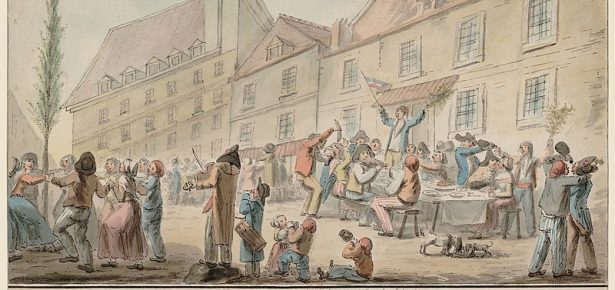
The U.S. Constitution of 1787 made no provisions for political parties. Only amidst the rivalries of the Washington administration, pitting Thomas Jefferson’s faction against Alexander Hamilton’s, did opposition politics coalesce. Even then, however, Jeffersonians remained reticent to mobilize the broader populace in support – that required the impact of the French Revolution. In early 1793, the new French republic sent a radical ambassador, Edmond-Charles Genêt, to destabilize the United States and bring it into the French Revolutionary Wars to aid its sister republic. Genêt arrived in Charleston (blown off-course) in April to popular celebrations, especially by the local French Patriotic Society already corresponding with the Paris Jacobins. The ambassador then made a seven-hundred-mile overland journey to the capital in Philadelphia, surrounded by “perpetual fêtes,” almost everywhere being celebrated as the embodiment of liberty and fraternity. Soon after a similar reception in the City of Brotherly Love, Genêt was invited to a meeting of the German Republican Society, where they sought to create a new national club network on the French Jacobins’ model. Locals proposed naming it the Sons of Liberty, but Genêt argued that the name should speak to the group’s core principles: “the Democratic Club,” soon elongated to “Democratic-Republican.”
Over the following months, the Democratic-Republican Societies coalesced across the fledgling United States, one in a long series of international exchanges that created modern social movements as we know them. The Sons of Liberty in 1765-6 had created a new model of affiliated, corresponding societies that over the following decades directly inspired new organizations for British Parliamentary Reform, Irish nationalism, international abolitionism, and campaigns for religious liberty, before the French Jacobins (founded in late-1789 explicitly on the model of London’s Revolution Society) ignited a second wave sparking new civil rights movements for Haitian free blacks and slaves, radical British political reform, Irish independence, and (finally) American party politics. Figures from Benjamin Franklin to Granville Sharp to Thomas Paine crossed between movements, organizers corresponded across the seas, newspapers reprinted ecstatic accounts from abroad, and all sought to develop a new political science that would spread liberty and participation.
On each occasion, the new organizations were founded on the inspiration of movements that had come before. Instead of seeing distinct national trajectories leading to divergent political traditions, focusing on the exchanges between these campaigns allows us to view the Age of Atlantic Revolutions as a totality. As Friends of Freedom, activists spoke across national boundaries, in hopes of inspiring a rising tide. Only in light of the accelerating flow of ideas, tactics, and events across international boundaries, challenging and often reconfiguring politics and society in each nation they touched, can the development of a common Revolutionary Era be understood.
Latest Comments
Have your say!